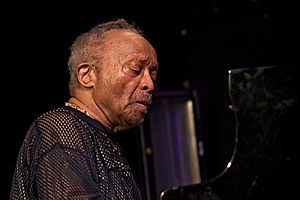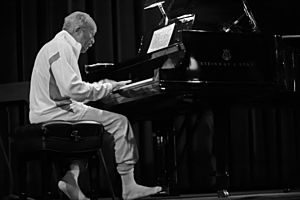Cecil Taylor facts for kids
Quick facts for kids
Cecil Taylor
|
|
|---|---|

Taylor at Moers Festival 2008
|
|
| Background information | |
| Birth name | Cecil Percival Taylor |
| Born | March 25, 1929 Long Island City, New York, U.S. |
| Died | April 5, 2018 (aged 89) Brooklyn, New York, U.S. |
| Genres | Jazz, avant-garde jazz, free jazz, free improvisation |
| Occupation(s) | Musician, bandleader, composer, poet |
| Instruments | Piano |
| Years active | 1956–2018 |
| Labels | Transition, Blue Note, Freedom, Hathut, Enja, FMP |
| Associated acts | Steve Lacy, Jimmy Lyons, Archie Shepp, Albert Ayler, Buell Neidlinger, Alan Silva, William Parker, Sunny Murray, Andrew Cyrille, Tony Oxley, Anthony Braxton, Alan Silva, Sirone, Art Ensemble of Chicago, John Coltrane |
Cecil Percival Taylor (born March 25, 1929 – died April 5, 2018) was an American jazz pianist and poet. He was known for his very energetic and unique way of playing the piano. He was one of the first musicians to create a style of jazz called free jazz.
Cecil Taylor's music often sounded like a powerful mix of sounds. He used many notes at once, sometimes hitting them like a drummer. One person even described his piano as "eighty-eight tuned drums," because of how he played it. He was a true pioneer in jazz music.
Contents
Early Life and Music Training
Cecil Percival Taylor was born in Long Island City, Queens, New York, on March 25, 1929. He grew up in Corona, Queens. He was an only child, and his mother encouraged him to play music from a young age.
He started playing the piano when he was six years old. Later, he studied music at the New York College of Music and the New England Conservatory of Music in Boston. There, he learned about composing music and arranging songs. He also discovered modern European art music, which influenced his own style.
In 1955, Taylor moved back to New York City. He formed a music group with other talented musicians. His first recording, Jazz Advance, came out in 1956. This recording showed hints of the new, free style of jazz he would later become famous for. His group also played at the 1957 Newport Jazz Festival.
Developing His Unique Jazz Style
Throughout the 1950s and 1960s, Cecil Taylor's music became more complex and moved away from traditional jazz. His unique way of playing made it hard to find places to perform. Club owners sometimes found his long, free-flowing songs difficult for their business.
His 1959 album Looking Ahead! showed how innovative he was. Unlike other musicians at the time, Taylor used very skilled techniques. He would quickly change styles within a song. These special qualities remained a key part of his music throughout his life.
Important albums like Unit Structures (1966) were released. In his group, often called the Cecil Taylor Unit, musicians could play together in new, conversational ways. Starting in 1961, Taylor worked closely with alto saxophonist Jimmy Lyons. Lyons became one of his most important partners. Lyons' playing helped keep Taylor's avant-garde (very new and experimental) music connected to jazz traditions.
Solo Performances and Growing Fame
In the late 1960s, Cecil Taylor began performing solo concerts. This meant it was just him and his piano. His first recorded solo show was in Rotterdam in 1967. Many of his later solo concerts were released as albums, like Indent (1973) and Silent Tongues (1974).
He started to gain more recognition and praise. He even played for President Jimmy Carter at the White House. He also taught at universities as an artist-in-residence. He received important awards, including a Guggenheim Fellowship in 1973 and a MacArthur Fellowship in 1991. These awards recognized his amazing talent and contributions to music.
Later Years and Collaborations
After Jimmy Lyons passed away in 1986, Taylor formed a new group called the Feel Trio in the late 1980s. This group included William Parker on bass and Tony Oxley on drums. Their music was even more abstract and experimental than his earlier work.
Taylor also performed with larger groups and big band projects. In 1988, he spent time in Berlin, Germany. During this time, he recorded many duets and trios with European musicians. Most of his later recordings were released by European labels.
Taylor continued to perform for large audiences around the world. He often played his favorite Bösendorfer piano, which had extra keys. A documentary film about him, called All the Notes, was released in 2006. He was also featured in a 1981 documentary called Imagine the Sound, where he talked about his music, poetry, and dance.
In the 2000s, Taylor recorded less often but continued to perform. He played with his own groups and with other musicians like Joe Locke and Max Roach. In 2013, he received the Kyoto Prize for Music. This award called him "An Innovative Jazz Musician Who Has Fully Explored the Possibilities of Piano Improvisation." In 2016, the Whitney Museum of American Art held a special event called "Open Plan: Cecil Taylor" to celebrate his work.
Ballet and Dance
Besides playing the piano, Cecil Taylor was always interested in ballet and dance. His mother, who passed away when he was young, was a dancer and also played music. Taylor once said, "I try to imitate on the piano the leaps in space a dancer makes."
He worked with dancer Dianne McIntyre in the late 1970s and early 1980s. In 1979, he wrote and performed music for a short ballet called "Tetra Stomp: Eatin' Rain in Space." Famous dancers like Mikhail Baryshnikov performed in it.
Poetry
Cecil Taylor was also a poet. He often included his poems in his musical performances. His poems also appeared in the notes inside his album covers. The album Chinampas, released in 1987, is a recording of Taylor reading his poems while playing percussion instruments.
Musical Style and Legacy
Many people believe that free jazz began with Cecil Taylor's performances in 1957. In 1964, Taylor helped create the Jazz Composers Guild. This group aimed to create more opportunities for avant-garde jazz musicians.
Cecil Taylor's music has been described as "constructivist" because of how he built complex sounds. While some found his music challenging, critics praised his "remarkable technique and endurance." They called his musical vision "advanced," "radical," "original," and uncompromising. He truly changed the way jazz could sound.
Personal Life and Death
Cecil Taylor moved to Fort Greene, Brooklyn, in 1983. He passed away at his home in Brooklyn on April 5, 2018, at the age of 89. At the time of his death, he was still working on new projects, including his autobiography.
Discography
Images for kids
See also
 In Spanish: Cecil Taylor para niños
In Spanish: Cecil Taylor para niños



